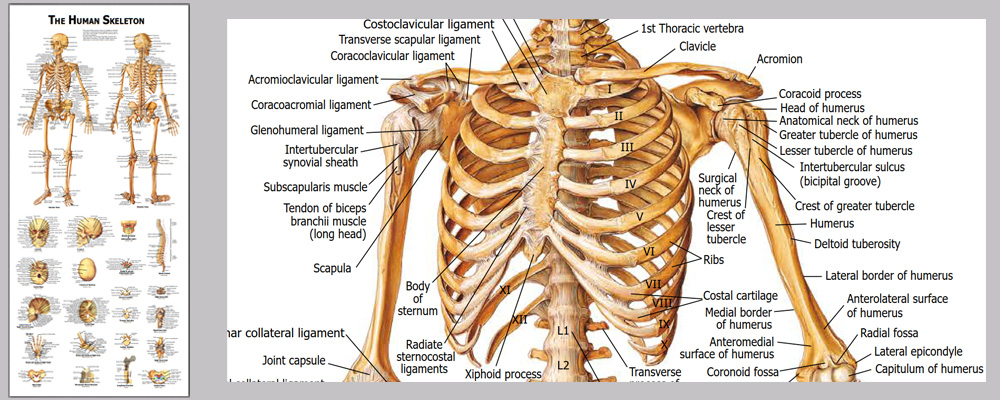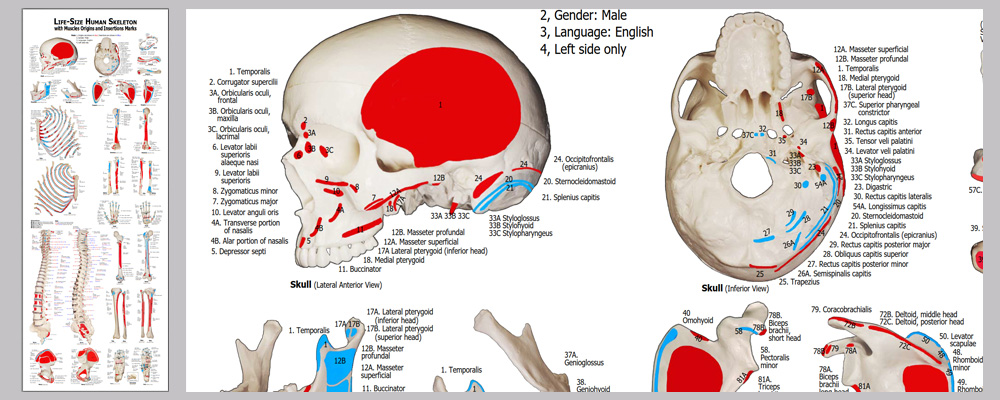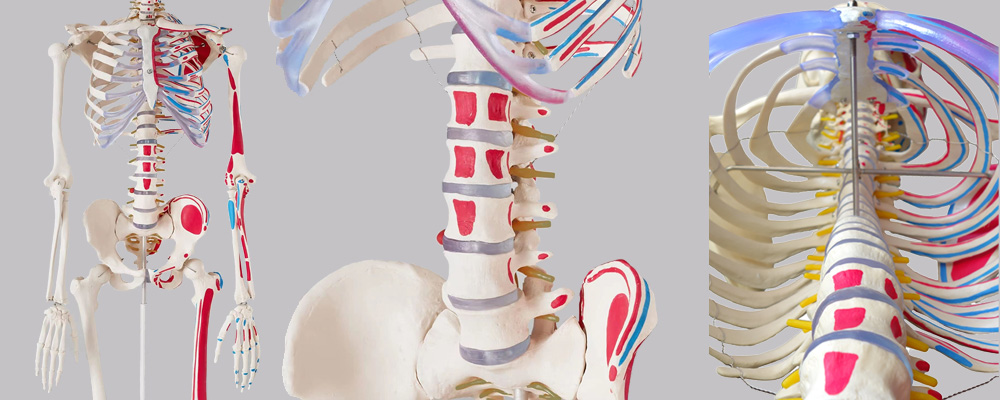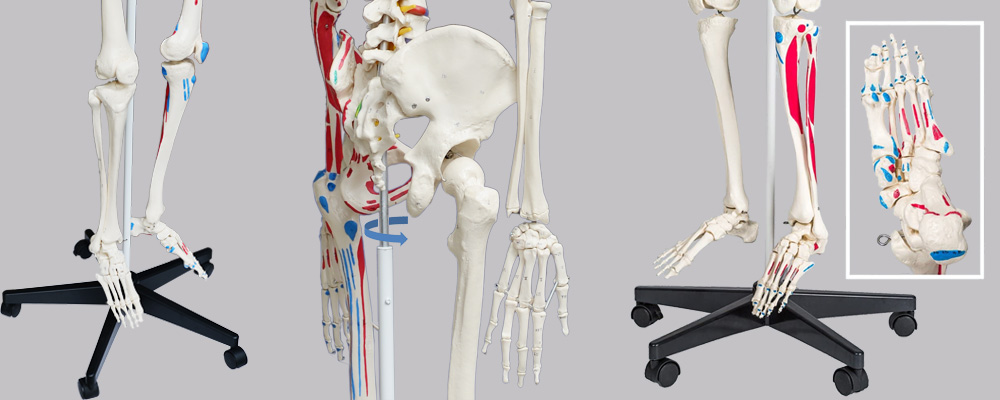human skeleton model brain
This life size articulated adult human skeleton model is 180cm tall & ideal for teaching / learning the basics of human anatomy. Includes a colorful Human Skeleton chart to show all the detailed structures for reference.Detailed colorful chart with over 630 accurate definitions. Durable and no reflection with matte film covered, 36 * 78cm

Detailed muscles origins and insertions with codes. Durable and no reflection with matte film covered, 100cm * 38cm

Stainless steel wires keep the ribs gaps stable.

2 of 5 casters are lockable.

With JC anatomy, you can also demonstrate the movements of the skull via the head joints, and thanks to the fully flexible spine, you can adjust the human skeleton model brain to place it in natural body postures. The unique combination of muscle origins and insertions, the numbered bones, flexible ligaments and flexible spine with a slipped disc between the 3rd and 4th lumbar vertebrae clearly the show medical and anatomical interest of this top model's more than 639 structures. Now available on a stable metal stand with 5 casters!
| Product name | human skeleton model brain |
| Place of Origin | Shenzhen China |
| Product Material | PVC, ABS, SST |
| Rib cage | A 5mm dia |
| Human skeleton model life | 19years |
| Surface treatment | Polish. Etched. Texture |
| SUPPORT 24/7 | Contact us 24 hours a day, 7 days a week |
| Size | 74 * 61 * 145 |
| Port | Shenzhen |
| PAYMENT & ORDERING | PayPal account or pay by credit card |
human skeleton model brain FAQs Guide Are you looking for a quick review guide about human skeleton model brain? An ultimate FAQs buying guide is available to help you.This guide contains all the information about all the important facts, figures, and various processes regarding human skeleton model brain. Let’s continue!
2.About human skeleton model brain production equipment
3.Does the human skeleton model brain have movable joints that can show the range of motion of various parts of the human body?
4.How similar is the human skeleton model brain appearance to a real human skeleton?
5.How durable is human skeleton model brain?
6.About the scale of human skeleton model brain factory
7.Is this human skeleton model brain suitable for anatomy learning?
8.Can bone diseases such as osteoporosis be displayed on the human skeleton model brain?
9.About human skeleton model brain delivery date
10.Can human skeleton model brain be used in medical research?
11.Can this human skeleton model brain be used as a simulation tool for sports training?
12.What kind of material is used to make the human skeleton model brain?
13.How to correctly assemble and utilize a human skeleton model brain?
14.About human skeleton model brain origin
1.Are human skeleton model brain joints elastic and flexible?
The human skeleton model joints are not entirely elastic and flexible, as they include various types of joints with different levels of flexibility. The elasticity and flexibility of a joint depend on its structure and function.
2.About human skeleton model brain production equipment
The production of a human skeleton model requires a variety of specialized equipment to ensure accuracy, durability, and detail in the final product. we around 50 sets dedicated equipment
3.Does the human skeleton model brain have movable joints that can show the range of motion of various parts of the human body?
Yes, the human skeleton model typically has movable joints that can show the range of motion of various parts of the human body. These joints are usually represented by different types of articulations such as ball and socket, hinge, saddle, pivot, and gliding joints, which mimic the movement of the actual joints in the human body. For example, the shoulder joint of a human skeleton model will have a ball and socket structure that allows for a wide range of motion, similar to the shoulder joint in a real human body. This joint is able to rotate 360 degrees and can also move forward, backward, and sideways. Similarly, the elbow joint in a human skeleton model will have a hinge structure that allows for flexion and extension movements, just like the elbow joint in a real human body. This enables the model to accurately demonstrate movements such as bending and straightening of the arm.
4.How similar is the human skeleton model brain appearance to a real human skeleton?
depending on the level of detail and accuracy that is represented. In general, a well-made human skeleton model will closely resemble a real human skeleton in terms of size, shape, and overall structure. The bones of a human skeleton model are typically made of a strong and durable material such as plastic or resin, and are molded and assembled to accurately represent the bone structure of a real human body. The proportions and dimensions of the bones are also generally accurate, with consideration given to the size and shape of bones in different areas of the body. In addition to the basic bone structure, a human skeleton model may also feature more detailed elements such as muscle attachments and articulations. These details help to further enhance the realism of the model and make it more closely resemble a real human skeleton.
5.How durable is human skeleton model brain?
The durability of a human skeleton model can vary depending on the materials used and the quality of construction. However, generally speaking, a high-quality skeleton model can be quite durable and can last for many years if properly cared for. Here are some factors that can affect the durability of a human skeleton model: 1. Materials: The most common materials used for human skeleton models are plastic, resin, and wood. Plastic and resin models are generally more durable as they are less prone to damage from impacts or moisture. Wood models can also be quite durable, but they may be more susceptible to wear and tear over time. 2. Maintenance: Proper maintenance and care can significantly increase the durability of a human skeleton model. Regular cleaning with a soft cloth and mild detergent can help keep the model free of dust and dirt. Additionally, storing the model in a protective case or covering can also help prevent damage. Overall, a high-quality human skeleton model can be quite durable and can last for many years with proper care. However, it is important to keep in mind that no model is completely indestructible, and regular wear and tear can occur over time.
6.About the scale of human skeleton model brain factory
Covering an area of about 2000 m². This would include manufacturing space for assembly, molding, and finishing processes, as well as storage space for raw materials and finished products.
7.Is this human skeleton model brain suitable for anatomy learning?
Yes, this human skeleton model is suitable for anatomy learning for several reasons. 1. Lifelike appearance: The model closely resembles the human skeleton in terms of size, shape, and detail. This makes it easier for students to visualize and understand the placement and functioning of bones in the human body. 2. Detailed labeling: The model comes with detailed labeling of all the bones and structures, helping students to learn the correct terminology and understand the location and function of each bone. 3. Removable parts: The model has removable limbs, joints, and other parts, allowing students to explore and study the underlying supportive, connective, and reproductive structures, such as ligaments, tendons, and cartilage. 4. Durable materials: The model is made of high-quality, durable materials that can withstand regular handling, making it suitable for use in classrooms, laboratories, and homes. 5. Realistic movement: The model's limbs can be moved in a way similar to human movement, making it an effective tool for demonstrating physiological processes and the range of motion of different joints. 6. Interactive learning: This model can be used in interactive learning sessions, such as small group discussions and hands-on activities, to foster a deeper understanding of the human skeleton and its functioning.
8.Can bone diseases such as osteoporosis be displayed on the human skeleton model brain?
Yes, bone diseases like osteoporosis can be displayed on a human skeleton model. A human skeleton model is a representation of the bones and joints of the human body and can be used to educate and train students and medical professionals. Osteoporosis is a bone disease that results in weakened and porous bones, increasing the risk of fractures. As a result, there are certain features and changes in the bone structure that can be seen on a human skeleton model.
9.About human skeleton model brain delivery date
Around 40 days. Depends on qty.
10.Can human skeleton model brain be used in medical research?
This model is mainly for displaying the skeleton structure, shapes, position relationship, and simulating joints movements, surface texture of the bones.
11.Can this human skeleton model brain be used as a simulation tool for sports training?
The Human skeleton model can definitely be used as a simulation tool for sports training. This model can be used in various ways to simulate different scenarios and movements that are specific to different sports. In conclusion, the Human skeleton model is a versatile tool that can be used to enhance sports training in various ways. It can help athletes and coaches understand and improve technique, prevent injuries, analyze and correct movement patterns, and simulate specific sports movements and scenarios. Thus, it can be a valuable resource for individuals looking to train and improve their performance in sports.
12.What kind of material is used to make the human skeleton model brain?
The human skeleton model is typically made out of a combination of materials, depending on the specific model and its intended use. Generally, the main materials used are plastic, metal, and sometimes, natural materials such as wood. Plastic: The majority of the skeleton model is made from a high-quality, durable plastic such as polyvinyl chloride (PVC) or polyethylene. These materials are lightweight and easy to mold into the intricate and specific shapes required for each bone in the skeleton. They are also easy to paint and can be colored to resemble real bones.
13.How to correctly assemble and utilize a human skeleton model brain?
When assembling and utilizing a human skeleton model, there are several steps to follow to ensure correct positioning and accurate representation of the skeletal system. Below is a step-by-step guide to properly assemble and utilize a human skeleton model: 1. Gather all the necessary components: The first step is to gather all the pieces of the human skeleton model, which typically includes a skull, rib cage, spinal column, arms, and legs. Make sure that all the pieces are present and in good condition. 2. Identify the bones: Before assembling the skeleton, it’s important to familiarize yourself with the different bones and their names. The skull, for example, has different parts such as the cranium, mandible, and maxilla, while the spinal column consists of the cervical, thoracic, lumbar, sacrum, and coccyx vertebrae. 3. Attach the arms and legs: Next, attach the arms and legs to the skeleton. Start by connecting the arms to the shoulder sockets and then attach the hand bones to the arms using the elbow and wrist joints. For the legs, connect the femur (thigh bone) to the hip socket, followed by the tibia and fibula (lower leg bones), and finally the foot bones.
14.About human skeleton model brain origin
Made in China




